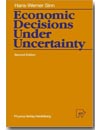This refers to risk-taking incentives created by limited liability. This theory was developed into an abstract theoretical risk model (expected utility and µ-σ-approach) and applied to the insurance market, currency speculation and other examples whereby a limitation of liability implies a low capital threshold. The mechanism described by this rule was crucially important in the financial crisis, as banks had taken excessively large risks because they expected their shareholders to benefit from high profits during good times, but knew that they would never stand to lose more than the capital that they had invested in bad times. The asymmetrical sharing of profits and losses meant that banks started to gamble.
Refereed scientific monographs
 Economic Decisions under Uncertainty, North Holland: Amsterdam, New York und Oxford 1983, 359 pages. (Translation of Ökonomische Entscheidungen bei Ungewißheit). Second English edition: Physica: Heidelberg 1989. Chapter III: The Structure of Risk Preference: Section B - The BLOOS Rule (PDF, 9.55 MB). To Amazon.
Economic Decisions under Uncertainty, North Holland: Amsterdam, New York und Oxford 1983, 359 pages. (Translation of Ökonomische Entscheidungen bei Ungewißheit). Second English edition: Physica: Heidelberg 1989. Chapter III: The Structure of Risk Preference: Section B - The BLOOS Rule (PDF, 9.55 MB). To Amazon.
Casino Capitalism. How the Financial Crisis Came about and What Needs to Be Done Now, Oxford University Press, Oxford 2010, 400 pages, second edition (Paperback) 2012. Korean edition, Ecopia, Korea, 2010, 421 pages; Chapter 4: “Why Wall Street Became a Gambling Casino” (Revised and updated translation of Kasino-Kapitalismus). To Amazon.
Reprints
Risk Taking, Limited Liability, and the Banking Crisis, Selected Reprints, Ifo Institute: Munich 2009, 200 pages.
Articles in refereed journals
"Kinked Utility and the Demand for Human Wealth and Liability Insurance", European Economic Review 17, 1982, pp. 149-162; (Download, 750 KB).